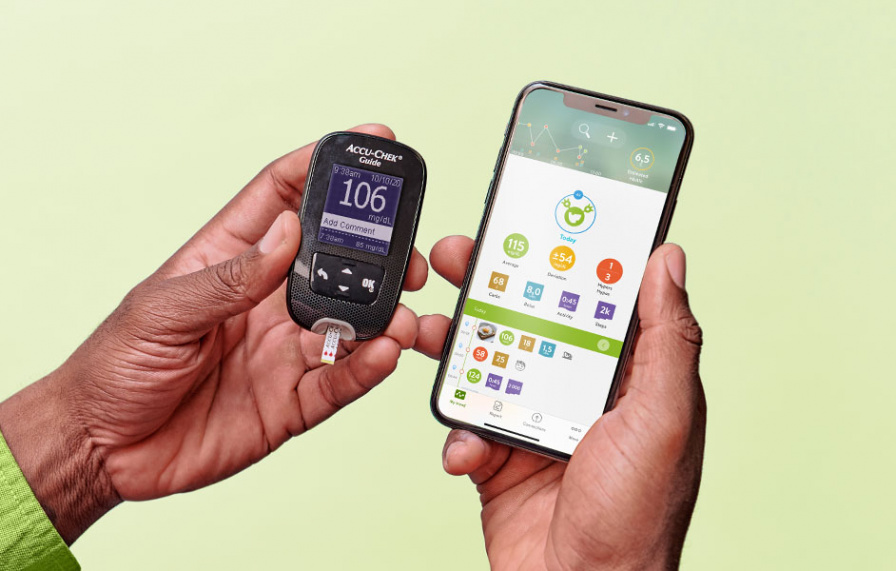Insulin on Board (IOB) refers to any insulin that is still active in your body from your last injection.
To understand how your IOB works, you will also need to know about the Active Insulin Time (AIT) or Duration of Insulin Action (DIA).
When you inject rapid-acting insulin, the insulin typically starts working within about 15 minutes, takes 1–2 hours to peak, and then continues to work in your body for 2–5 hours. Injecting more insulin during this time, and not considering IOB, can result in insulin stacking.
Knowing how much insulin is on board will help you get a more accurate insulin dosage, and will thereby improve your time in range.
Let us look at an example, to help make sense of this concept.
You are about to have a meal containing 45g of carbs. Your insulin to carb ratio is 1:15 and your insulin sensitivity factor is 2.5mmol/L. Your blood glucose level is 10.5, with a BG target of 5.5mmol/L. How much insulin do you estimate your pump would deliver?
If you said 5 units, you would be right. UNLESS you have any active insulin on board.
If your AIT is 4 hours, and your previous insulin injection was done 3 hours ago you will still have insulin on board. This will be deducted from the above amount.
Now, if you still had 2 units on board, then you will only need 3 units of insulin for this particular meal. If you would take the full 5 units you could be at risk of a hypo.
All current insulin pumps have an IOB feature. If this feature is activated, your pump will deduct any IOB from your bolus calculation. This means less risk of insulin stacking and it provides greater flexibility, as you can give more frequent boluses for snacks or as corrections, with less risk of hypos.
If you are using an insulin pump you can see if you have any insulin on board from your status screen. If you are on multiple daily injections (MDI) you could consider the use of an insulin bolus calculator
Calculating IOB
The way your pump calculates IOB, and how this is applied in bolus calculations can vary depending on the type of pump you have.
In some pumps IOB is only deducted from correction boluses, not the full meal bolus. This means that the full amount of IOB is not always deducted.
For example: if the correction bolus is 3 units and there are 2 units of IOB, the full 2 units are deducted. But if the correction bolus is 1 unit, only 1 of the 2 units of IOB will be deducted.
In other pumps both meal and correction boluses are considered when calculating IOB, but IOB is only deducted from correction bolus amounts if your glucose level is above target. If your BGL is below target the full amount of IOD is subtracted from the total bolus (including the food portion. This means that a small difference in BGL (just above versus just below the target BG) can result in very different bolus calculations. Let me explain with another example:
Your target BG is 7 mmol/l and your current reading is 10 mmol/l. Let’s say your total bolus is 7 units (5 for the meal + 2 for correction). Without any IOB, you would receive the full 7 units. But if you have 4 units of IOB, the correction bolus is reduced to zero, and the recommended dose would be just the 5 units for the meal.
But if your blood sugar is 5 mmol/l, and the usual dose is 4 units (5 for the food, -1 for the correction), the 4 units of IOB would be deducted from the 4-unit total, resulting in a recommended dose of zero.
And then there are some pumps that will only consider boluses that were given to correct high BGLs, when calculating IOB. These pumps assume that any insulin left from a meal bolus is covering any food that is still being digested from that previous meal. This leads to much lower IOB calculations than other pumps, and hence less bolus reduction (in other words more aggressive boluses, increased risk of hypos).
For example: if you gave 6 units for a meal and 2 units to cover an above-target reading, the 6 units is ignored in all IOB calculations in these types of pumps. Only the 2-unit correction portion is considered.
IOB and MDI
It is a little trickier to establish any active insulin if you are on multiple daily injections.
While it is possible to calculate IOB manually, it can be difficult and inconvenient. Luckily there are good apps that can assist you. Apps can range in functionality; some good options are:
- Accu-Chek®Connect app by Roche Diabetes Care Australia
- The mylifeTMApp by Ypsomed Australia
- The mySugr Bolus Calculator Appby Roche Diabetes Care Australia
All three of these apps are available in the App Store and on Google Play.

